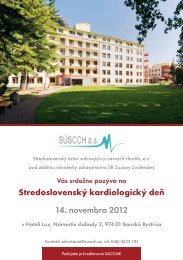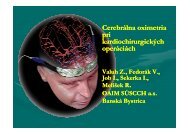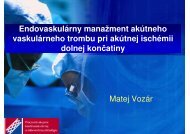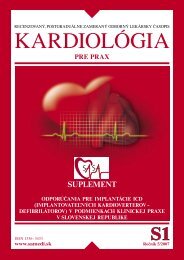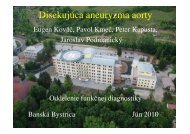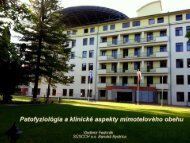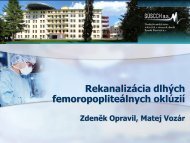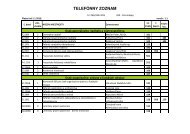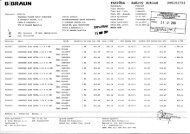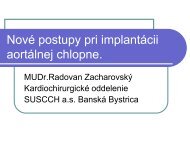Management of acute myocardial infarction in patients presenting ...
Management of acute myocardial infarction in patients presenting ...
Management of acute myocardial infarction in patients presenting ...
You also want an ePaper? Increase the reach of your titles
YUMPU automatically turns print PDFs into web optimized ePapers that Google loves.
ESC Guidel<strong>in</strong>es 2937<br />
e. Networks<br />
As <strong>in</strong>dicated above, the implementation <strong>of</strong> a network <strong>of</strong> hospitals<br />
connected by an efficient ambulance (helicopter) service and us<strong>in</strong>g<br />
a common protocol is key for an optimal management <strong>of</strong> <strong>patients</strong><br />
with STEMI.<br />
With such a network <strong>in</strong> place, target delay times should be:<br />
,10 m<strong>in</strong> for ECG transmission; 5 m<strong>in</strong> for tele-consultation;<br />
,30 m<strong>in</strong> for ambulance arrival to start fibr<strong>in</strong>olytic therapy; and<br />
120 m<strong>in</strong> for ambulance arrival to first balloon <strong>in</strong>flation. Quality<br />
<strong>of</strong> care, appropriateness <strong>of</strong> reperfusion therapy, delay times, and<br />
patient outcomes should be measured and compared at regular<br />
times, and appropriate measures for improvement should be taken.<br />
f. General practitioners<br />
In many countries, general practitioners still play a major role <strong>in</strong> the<br />
early care <strong>of</strong> STEMI. In these countries they are <strong>of</strong>ten the first to<br />
be called by <strong>patients</strong>. If they respond quickly, they can be very<br />
effective s<strong>in</strong>ce they usually know the <strong>in</strong>dividual patient and can<br />
take and <strong>in</strong>terpret the ECG, are able to adm<strong>in</strong>ister opioids, to<br />
call the ambulance service, and undertake defibrillation if<br />
needed. 242,248 In other circumstances, consultation with a general<br />
practitioner is one <strong>of</strong> the reasons for an <strong>in</strong>creased pre-hospital<br />
delay. 249,250<br />
g. Admission procedures<br />
The process<strong>in</strong>g <strong>of</strong> <strong>patients</strong> once they arrive <strong>in</strong> hospital must be<br />
speedy, particularly with regard to the diagnosis and adm<strong>in</strong>istration<br />
<strong>of</strong> fibr<strong>in</strong>olytic agents or the performance <strong>of</strong> a primary PCI, if <strong>in</strong>dicated.<br />
Candidates for primary PCI must be admitted directly to the<br />
cath lab, bypass<strong>in</strong>g the emergency room and/or ICCU, while<br />
<strong>patients</strong> candidate for fibr<strong>in</strong>olysis must be treated directly <strong>in</strong> the<br />
emergency room. 251<br />
2. The Intensive Cardiac Care Unit<br />
STEMI <strong>patients</strong> should be admitted to ICCUs after the <strong>in</strong>itial reperfusion<br />
therapy, which is given <strong>in</strong> the ambulance, <strong>in</strong> the emergency<br />
room, or <strong>in</strong> the cath lab. ICCUs should be equipped adequately<br />
and staffed with dedicated and properly tra<strong>in</strong>ed physicians and<br />
nurses, due to the <strong>in</strong>creased complexity <strong>of</strong> older and sicker<br />
<strong>patients</strong>.<br />
a. Non-<strong>in</strong>vasive monitor<strong>in</strong>g<br />
ECG monitor<strong>in</strong>g for arrhythmias and ST-segment deviations<br />
should be started immediately <strong>in</strong> any patient suspected <strong>of</strong> hav<strong>in</strong>g<br />
susta<strong>in</strong>ed a STEMI. This should be cont<strong>in</strong>ued for at least 24 h.<br />
Further ECG monitor<strong>in</strong>g for arrhythmias is dependent upon the<br />
perceived risk and upon the equipment available. When a patient<br />
leaves the ICCU, monitor<strong>in</strong>g <strong>of</strong> rhythm may be cont<strong>in</strong>ued, if<br />
necessary, by telemetry. A more prolonged stay at the ICCU is<br />
appropriate for those who have susta<strong>in</strong>ed heart failure, shock, or<br />
serious arrhythmias <strong>in</strong> the <strong>acute</strong> phase, as the risk <strong>of</strong> further<br />
events is high.<br />
b. Invasive monitor<strong>in</strong>g<br />
All ICCUs should have the skills and equipment to undertake<br />
<strong>in</strong>vasive monitor<strong>in</strong>g <strong>of</strong> the arterial and pulmonary artery<br />
pressures. Arterial pressure monitor<strong>in</strong>g should be undertaken<br />
<strong>in</strong> <strong>patients</strong> with cardiogenic shock. Pulmonary artery catheters<br />
have been used for a long time <strong>in</strong> ICCUs <strong>in</strong> haemodynamically<br />
unstable <strong>patients</strong>. However, recent studies 252–254 did not<br />
show a benefit <strong>of</strong> a rout<strong>in</strong>e use <strong>of</strong> these procedures on<br />
mortality or on the length <strong>of</strong> the hospital stay. A restricted use<br />
is recommended.<br />
3. The post-discharge period<br />
Multidiscipl<strong>in</strong>ary rehabilitation services should be available, and<br />
follow-up <strong>of</strong> the secondary prevention programme should be<br />
organized before discharge.<br />
J. Gaps <strong>in</strong> evidence<br />
There is limited experience with PCI <strong>in</strong> STEMI <strong>patients</strong> present<strong>in</strong>g<br />
more than 12 h after onset <strong>of</strong> symptoms. Transport<strong>in</strong>g <strong>patients</strong><br />
from a community to a PCI-capable hospital for primary PCI<br />
rema<strong>in</strong>s a challenge. Even <strong>in</strong> the best networks many <strong>patients</strong> are<br />
treated with PCI outside the recommended time w<strong>in</strong>dow. It is<br />
unknown whether pre-hospital fibr<strong>in</strong>olysis dur<strong>in</strong>g transport to a<br />
PCI-capable hospital <strong>in</strong> <strong>patients</strong> present<strong>in</strong>g early to the EMS is<br />
beneficial if the <strong>in</strong>tervention cannot be performed with<strong>in</strong> the<br />
recommended time w<strong>in</strong>dow. Cardiologists <strong>in</strong> community hospitals<br />
are still uncerta<strong>in</strong> which pharmacological treatment to start before<br />
transport. A number <strong>of</strong> <strong>patients</strong> need oral anticoagulation after<br />
primary PCI with stent<strong>in</strong>g. Whether aspir<strong>in</strong> and/or an ADP antagonist<br />
added to coumar<strong>in</strong>s are effective and safe <strong>in</strong> all <strong>patients</strong> is<br />
unknown as is the optimal duration <strong>of</strong> this antithrombotic<br />
regimen. Randomized studies <strong>in</strong> <strong>patients</strong> with mechanical complications<br />
are lack<strong>in</strong>g.<br />
K. Procedures <strong>of</strong> the Task Force<br />
This Task Force was created by the ESC <strong>in</strong> 2006. Individual<br />
members were <strong>in</strong>vited to update sections <strong>of</strong> the 2003 guidel<strong>in</strong>es<br />
<strong>in</strong> their area <strong>of</strong> expertise. These were discussed at meet<strong>in</strong>gs <strong>in</strong><br />
Frankfurt on March 16, 2007 and January 8, 2008. After several<br />
revisions, the f<strong>in</strong>al document was submitted to the Committee<br />
for Practice Guidel<strong>in</strong>es for approval on August 19, 2008. Invaluable<br />
assistance <strong>in</strong> process<strong>in</strong>g the document was provided by Veronica<br />
Dean, Kar<strong>in</strong>e Piellard (ESC), Krista Bogaert, Anita Meuris, and<br />
Roos Struyven (University <strong>of</strong> Leuven). The guidel<strong>in</strong>es were<br />
developed without any <strong>in</strong>volvement <strong>of</strong> the <strong>in</strong>dustry.<br />
Recommendations <strong>of</strong> guidel<strong>in</strong>es have <strong>of</strong>ten not been<br />
implemented <strong>in</strong> practice, and treatments which have been shown<br />
to be <strong>of</strong> little or no value cont<strong>in</strong>ue to be used widely. For <strong>in</strong>stance,<br />
large registries have demonstrated that 30% <strong>of</strong> all STEMI <strong>patients</strong><br />
did not receive reperfusion therapy. 255 – 257 There is a great need<br />
both for cont<strong>in</strong>u<strong>in</strong>g medical education and for ongo<strong>in</strong>g audit to<br />
ensure the implementation <strong>of</strong> guidel<strong>in</strong>es. Task Forces should play<br />
an active role <strong>in</strong> this effort.<br />
The electronic version <strong>of</strong> this document is available on the<br />
website <strong>of</strong> the European Society <strong>of</strong> Cardiology: www.escardio.<br />
org <strong>in</strong> the section ‘Scientific <strong>in</strong>formation’, Guidel<strong>in</strong>es.



